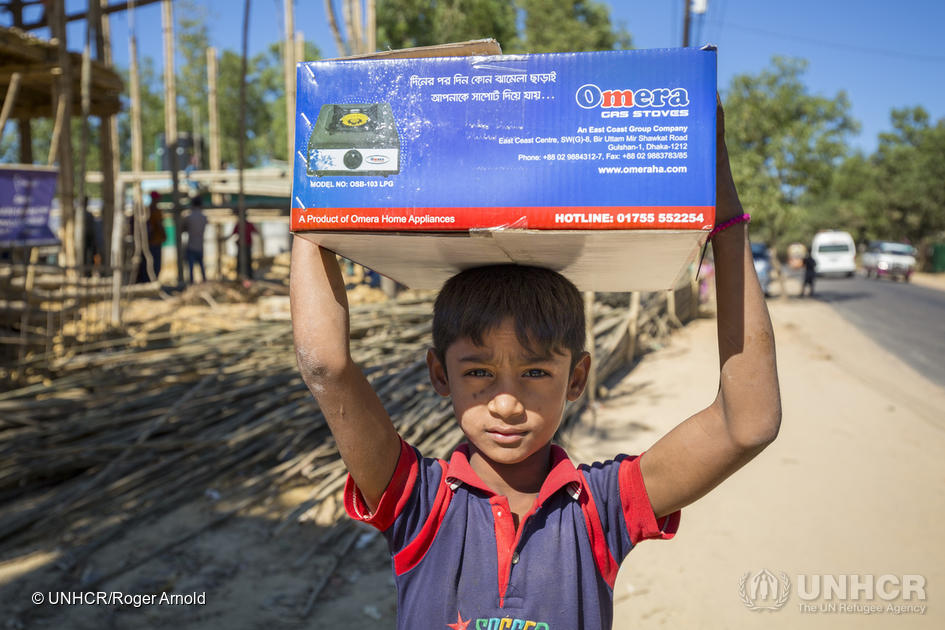Over a million Rohingya refugees have fled violence in Myanmar in successive waves of displacement since the early 1990s. Follow the crisis here.
The Rohingya are a stateless Muslim minority in Myanmar. The latest exodus began on 25 August 2017, when violence broke out in Myanmar’s Rakhine State, driving more than 742,000 to seek refuge in Bangladesh. Most arrived in the first three months of the crisis. An estimated 12,000 reached Bangladesh during the first half of 2018. The vast majority reaching Bangladesh are women and children, and more than 40 per cent are under age 12. Many others are elderly people requiring additional aid and protection. They have nothing and need everything.
Nearly all who arrived during the influx have sought shelter in and around the refugee settlements of Kutupalong and Nayapara in Bangladesh’s Cox’s Bazar district. Some have joined relatives there. The enormous scale of the influx is putting an immense pressure on the Bangladeshi host community and existing facilities and services.
“They burnt our house and drove us out by shooting. We walked for three days through the jungle.”
Mohammed, who fled to Bangladesh with his family of seven, including a baby born along the way
New spontaneous settlements sprouted overnight, raising concerns over the lack of adequate shelter, water and sanitation, access to basic services, and general protection considerations such as safety for women and girls. The Kutupalong refugee settlement has grown to become the largest of its kind in the world, with more than 600,000 people living in an area of just 13 square kilometres, stretching infrastructure and services to their limits.The Bangladesh government has responded generously throughout the latest crisis. Local Bangladeshi villages have also taken in the new arrivals. They spared no effort to help, straining their already limited resources.The humanitarian response in Bangladesh remains focused on meeting the massive humanitarian needs and on mitigating the impact of the seasonal monsoon rains. However, additional international support is urgently needed to step up the assistance from purely humanitarian and day-to-day support towards addressing medium-term challenges, including resilience, education, registration, and programmes to protect the most vulnerable refugees – including children, women and persons with specific needs.
What is UNHCR doing to help?
ogether with our partners we are working in support of the Bangladesh government to respond to the massive humanitarian needs.
In the opening days, weeks and months of the crisis, UNHCR airlifted more than 1,500 metric tons of emergency life-saving aid to Bangladesh – including blankets, plastic sheets, sleeping mats, family tents, plastic rolls, kitchen sets, jerry cans and buckets.
Together with our partners, we are also helping the government to develop new sites that can safely accommodate refugees. This includes funding a road to facilitate construction and refugee access, supporting site planning, building latrines and wells, improving the water and sanitation facilities and distributing shelter materials.
In an effort to improve sanitation and access to drinkable water, we have built thousands of latrines and water points for the refugees, thereby mitigating the risks of health problems such as acute watery diarrhoea.
UNHCR is working to mainstream refugee protection in all refugee settlements. With its partners, it is developing a referral system and safe spaces for survivors of gender-based violence. We are also enhancing efforts to identify and refer children at risk for the appropriate support.
UNHCR has increased its presence in the field through the deployment of emergency teams and relief specialists in different sectors. We have 300 staff in Bangladesh, including 208 national colleagues. We will continue to boost our presence and operations to match the scale and complexity of this still fluid and evolving refugee crisis.
On 16 March 2018, the UN and its partners launched a Joint Response Plan (JRP) for the Rohingya Humanitarian Crisis calling for US$951 million to continue delivering lifesaving assistance from March to December 2018. As of early August 2018, the JRP remains just 32 per cent funded. UNHCR is appealing for US$238.8 million as part of its Supplementary Appeal for 2018 in order to continue to respond to the needs of hundreds of thousands of refugees.
Monsoon response
UNHCR rushed additional aid to Bangladesh to prepare refugees and host communities for the monsoon rains, which fall between May and September, increasing the risk of floods and landslides. Hundreds of thousands of Rohingya refugees have found shelter in Cox’s Bazar district – one of the wettest areas of the country. Humanitarian partners estimate that up to 200,000 Rohingya refugees could be at risk during the monsoon season. Many live on rugged, undulating terrain prone to landslides and flooding and are in urgent need of relocation.
Among them, some 41,000 refugees live in areas deemed at highest risk of landslides. By mid-August 2018, more than 24,000 of them had been relocated by UNHCR to safer areas.
UNHCR has also equipped more than 80,000 refugee families with upgraded shelter kits, which include bamboo poles, ropes, shelter-grade tarpaulins, sandbags, and tools. In addition, the Bangladesh government, supported by UNHCR and its partners, have added 32 kilometres of brick roads and footpaths, 91 kilometres of drainage pipes, and has constructed 45 kilometres of steps across the settlement. In addition, 63 kilometres of retaining walls and structures; 94 kilometres of drainage have been completed or repaired; 2,324 meters of bridges have been built. UNHCR has also strategically prepositioned 116 storage containers with emergency aid and upgraded 20 community buildings and facilities in the Bangladeshi host communities.
